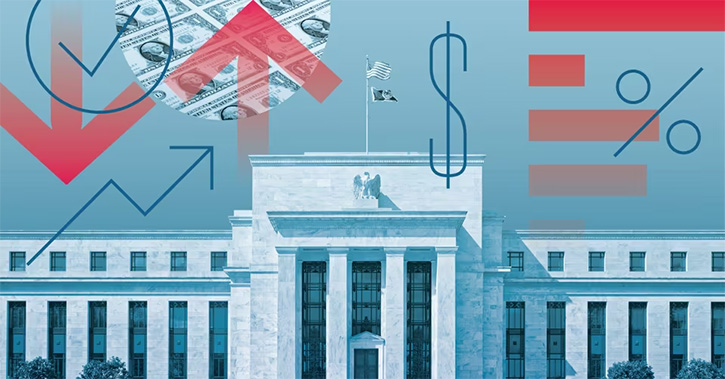
The June Consumer Price Index report from the US brought good news for investors and consumers alike, but that may not deter the Federal Reserve from hiking interest rates later this month.
“Inflation is now showing broad-based signs of deceleration,” Morningstar chief economist Preston Caldwell says. “The Fed is still likely to hike in its July meeting, but today’s report supports our view that the Fed will pivot to aggressive cutting in 2024 after inflation falls.”
Unlike in the UK, annual rate of inflation in the US is now at the slowest it has been in just over two years. Inflation is up 3.0% in June from its year-ago levels – the smallest increase since March 2021. While the rate of inflation in the June CPI report remains above where the Fed wants it to be, the data suggests clear progress in getting price pressures down toward more acceptable levels.
“Today’s report bolsters our view that inflation is headed down, eventually clearing the way for large interest-rate cuts,” Caldwell says.
CPI Report Reveals Slowing Inflation
“Overall, CPI inflation is homing in on the Fed’s 2% target,” Caldwell says, noting that the latest reading is well below its peak of 8.9% in June 2022. By his measure, on an annualised basis, overall inflation has averaged 2.7% in the last three months.
“Heretofore, progress on inflation was mainly attributable to lower food and energy inflation. But now, crucially, we’re also seeing improvement in terms of core inflation,” he explains.
The Bureau of Labor Statistics reported that the CPI rose 3.0% in June from year-ago levels – the slowest increase since March 2021 and smaller than economists’ forecasts of 3.1%. The core CPI, which excludes volatile food and energy costs, rose 4.8% in June from year-ago levels after rising 5.3% in May.
The CPI rose 0.2% in June from the previous month – slower than economists’ expectations, but a slight increase from the 0.1% rise in May. Core CPI rose 0.2% in June – slower than economists’ forecasts for the month and slower than the 0.4% rise in May.
The Fed is meeting on July 25 and 26 to determine its next steps against this backdrop of slowing but still-elevated inflation. In the bond market, most investors expect the regulator to raise the federal-funds rate by 0.25 percentage points and then keep it there for the rest of the year.
June US CPI Report Key Stats
- CPI rose 0.2% for the month versus 0.1% in May
- Core CPI rose 0.2% after rising 0.4% in May
- CPI rose 3.0% year over year after rising 4.0% in May
- Core CPI rose 4.8% year over year after rising 5.3% in May
Under the hood, shelter was again the largest contributor to rising prices, accounting for over 70% of the total increase. Motor vehicle prices also made a significant contribution. Food prices ticked upward in June, rising 0.1% after rising 0.2% in May. Food-at-home prices held steady, while food-away-from-home prices rose 0.4%. Energy prices rose over the month.
'Supercore' Inflation Slows
“One crucial indicator for inflationary momentum is core services excluding shelter and healthcare, often dubbed ‘supercore’ inflation,” Caldwell says. “It is held by the Fed to be a good gauge of inflation’s underlying trend.”
Supercore inflation was just 2.7% in the past three months, by Caldwell’s measure. “Admittedly, this inflation measure is very volatile, and plunging airline fares contributed a 1.5% negative impact,” he says. “Yet we still see signs of broad-based deceleration in inflation in the consumer services sector. This is likely in part a response to moderating wage inflation.”
Core Goods and Services Inflation
Overall, core inflation has posted a 4.1% annualised increase over the past three months, according to Caldwell, down from 5.1% in the three months ending in March.
“The story on core inflation has shifted abruptly at several junctures in the past year. First, in late 2022 we saw core inflation excluding shelter (housing) prices fall sharply, while shelter inflation soared,” Caldwell says. “Then, in early 2023, shelter inflation fell, but this was offset by renewed high inflation in other parts of the index (especially used vehicles).” Now, he says, it looks like most components of core inflation are finally falling in concert.
In June, shelter prices rose 0.4% after rising 0.6% in May. Prices for new vehicles held steady over the month, while used car and truck prices fell 0.5%.
Energy prices rose 0.8% for the month after falling 3.6% in May. Within the energy component for June, gasoline prices rose 1.0%, electricity prices rose 0.9%, and utility (piped) gas services prices fell 1.7%.
Fed Is Expected to Raise Rates in July, Then Hold Them
It will take more good news on inflation to convince the Fed to hold rates steady at its upcoming meeting. “One month’s worth of data won’t be enough to dissuade the Fed from hiking in its July meeting,” Caldwell says. “This is especially the case given that many committee members already had wished to hike in June.” Additionally, Caldwell thinks that labour market data is still running hot and that other measures of economic activity still look robust.
“Regardless, today’s news will eventually lead to looser monetary policy. Accordingly, the two-year Treasury yield has fallen around 17 basis points on today’s news, implying a lower path for the federal-funds rate over the next two years,” he says.
This article originally appeared on Morningstar.com and has been edited and republished for a UK audience



























